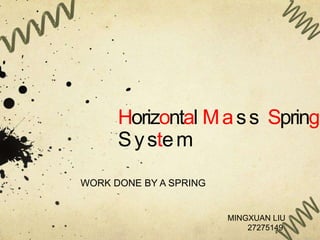
Lo1 liu
- 1. Horizontal Mass Spring System WORK DONE BY A SPRING MINGXUAN LIU 27275149
- 2. Some facts about a spring A spring always keeps its original length. The force exerted by a spring is proportional to its stretched/compressed length. Thus, the force for holding a spring is not a constant but can be calculated using Hooke’s law. Where F is the force exerted by the spring, k is the spring constant showing how much the force increase with stretched/compressed length, x is the stretched/compressed length.
- 3. Work done by a spring In high school we known that the work done by something equal to the product of the exerted force and moving distance. Applying the work equation and the force exerted by a spring, the work done by a spring is: After evaluating this integral we have: Where x1 is the initial position, and x2 is the final position. Images from Physics For Scientists And Engineers – 1e
- 4. A interesting problem showing how energy is converted Suppose there is a tower that is 16 meters tall. Two identical spring A, B of natural length 3m and spring constant 200N/m are assembled on the floor and ceiling. Both of them point toward each other directly. A metal ball of mass 5kg is placed on the bottom spring(A) and pushed by its maximum force (by which the spring is compressed to 10% of its natural length) of the spring. Ignoring the air resistance and energy losing, assume that the ball moves perpendicular to the ground without any angle: After the spring is released, will the ball hitting the upper spring (B) on the ceiling? If so, how much (as much as possible) will the spring (B) be compressed in meters?
- 5. Solution to the problem 16m 3m 2.7m 0.3m 5kg 200N/m 200N/m Step1: Sketch the picture with all the key information labeled on it. From the picture we know that since the floor and ceiling are fixed, when spring A is released, the ball moves upward and may hit the upper spring. Step2: Figure out how the energy converts among the ball, spring A and spring B. When spring A is released: Work done by A = Kinetic plus gravitational potential energy of the ball = Gravitational potential energy of the ball when reach the highest possible height If you are confused think about that if the ceiling is high enough and at the time the velocity of the up moving ball decrease to 0, it reaches the highest point. Then fall down.FLOOR CEILING A B
- 6. Solution to the problem 16m 3m 2.7m 0.3m 5kg 200N/m 200N/m Gravitational potential energy of the ball at the highest possible height is given by: Ep=mballghmax We know that all of the gravitational potential energy comes from the spring. Espring Ek+Ep Ep The work done by spring A is given by: Ws=-0.5kx2 2 (x1=0) Combine two equation we have: -Ep=Ws mballghmax=0.5kx2 2 5.0kg*9.8m/s2*hmax=0.5*200N/m*(0.9*3m)2 hmax= (0.5*200N/m*(0.9*3m)2)/(5.0kg*9.8m/s2) hmax = 14.88m (hit the upper spring) FLOOR CEILING A B Increase Height Change the sign! hmax
- 7. Solution to the problem 16m 3m 2.7m 0.3m 5kg 200N/m 200N/m Step3: Now we know that the ball will hit spring B, but how much will the spring be compressed? Consider that the total energy in this system doesn’t change. If something loses its energy, something must gain that amount of energy. When the ball is on its way up, work done by spring A convert into both EK and Ep of the ball. Also, Ek goes into Ep at the same time by lowering the upward velocity. After the ball contact with spring B, part of its Ek goes into the potential energy of spring B and part of its Ek goes into Ep. AND Ek IS TOTALLY CONVERTED WHEN SPRING B IS COMPRESSED AS MUCH AS POSSIBLE. When this point is reached, the ball is at a rest, all of it energy takes form of Ep. Let h be the distance between where spring A is compressed and the point where the ball is almost touching spring B. Let FLOOR CEILING A B origina l x h
- 8. Solution to the problem 16m 3m 2.7m 0.3m 5kg 200N/m 200N/m Step4: Imaging if there is no upper spring, the ball can go as high as about 15m. However, the presence of spring B trapped the ball and absorb some of its energy. Without the ceiling, the ball at max height has energy: EP=mballghmax (assume that +0.3m is the ground level) With the ceiling, the ball at max height has energy: EP=mballg(h+x) THUS, THE ENERGY DIFFERENCE IN THESE TWO SITUATIONS SHOULD EQUAL TO THE ENERGY ABSORBED BY SPRING B. If you are still confused, consider that (h+x) is a smaller number than hmax, the ball with hmax has a larger energy. FLOOR CEILING A B origina l x h=12.7
- 9. Solution to the problem 16m 3m 2.7m 0.3m 5kg 200N/m 200N/m Combine the equation we get: EspringB = -WspringB= mballghmax -mballg(h+x) 0.5*200N/m*x2=5.0kg*9.8m/s2(14.88m-x- 12.70m) 100x2=49(2.18-x) 100x2+49x-106.82=0 x=0.82m (discard the negative value) Conclusion: The ball will hit the upper spring and cause a compress of 0.82m to it. The key part of this problem is realizing how the energy is converted in the spring system. Once you master where the energy goes and build a energy balance equation, the reaming part is just doing algebra. FLOOR CEILING A B origina l x h=12. 7
- 10. The end Thanks for watching.